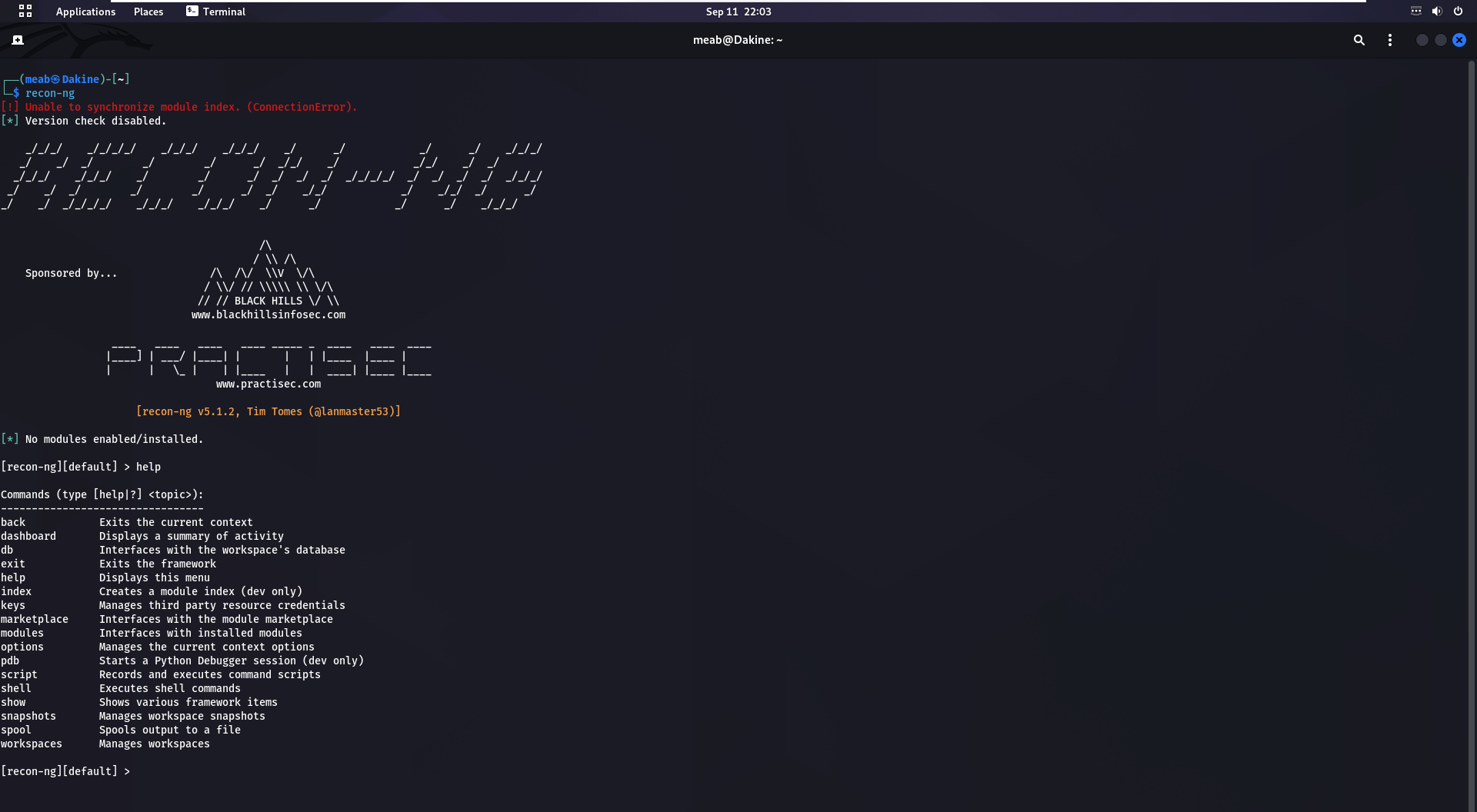Key Takeaway:
- Recon-ng is a powerful tool for footprinting and web reconnaissance: It provides a comprehensive suite of modules and techniques to gather information about a target, enabling security professionals to assess vulnerabilities and potential attack surfaces.
- Installing and setting up Recon-ng is straightforward: By following the installation instructions, security professionals can quickly have Recon-ng up and running on their system, ready to perform reconnaissance tasks.
- Effective utilization of Recon-ng modules is essential: By understanding the categorization and exploration of modules, security professionals can efficiently gather information such as subdomains, open ports, email addresses, and social media profiles, aiding in the reconnaissance process.
- Advanced techniques and best practices enhance reconnaissance outcomes: By leveraging advanced techniques such as automated scans, exploiting misconfigurations, and utilizing data enrichment services, security professionals can optimize their reconnaissance efforts and uncover valuable insights.
- By using Recon-ng, security professionals can empower their web reconnaissance activities: With its extensive capabilities and flexibility, Recon-ng enables professionals to conduct thorough footprinting and reconnaissance, leading to improved security posture and more effective vulnerability management.
Introduction: The Significance of Recon-ng in Footprinting and Web Reconnaissance
In the ever-evolving realm of footprinting and web reconnaissance, Recon-ng stands as a crucial tool. Its importance lies in its ability to gather valuable information and conduct thorough investigations on targeted systems and web entities. With Recon-ng, analysts can delve deep into the intricacies of their targets, uncovering crucial details that aid in understanding vulnerabilities, detecting potential threats, and formulating effective strategies. Harnessing the power of Recon-ng enables professionals to stay ahead in the game, ensuring comprehensive reconnaissance and helping them make informed decisions to mitigate risks effectively.
Recon-ng Installation and Setup
Recon-ng Deployment and Configuration
Prepare for Recon-ng implementation and customization with this professional guide. Follow a tailored approach encompassing the four key steps listed below:
1. Obtain Recon-ng: Download the Recon-ng software from a trusted source or use the recommended package manager for effortless installation.
2. Configure Dependencies: Ensure that the necessary dependencies are available, such as Python, pip, and SQLite3. Update any outdated packages to maintain compatibility.
3. Set Up Recon-ng: Execute the installation command and allow Recon-ng to seamlessly set up its configuration files, ensuring that the tool operates effectively.
4. Customize Recon-ng: Enhance your Recon-ng experience by exploring the customizable features and plugins. Tailor Recon-ng to your specific requirements and maximize its potential.
Additionally, we recommend familiarizing yourself with the specific details of Recon-ng installation and setup to have a comprehensive understanding of its capabilities.
True Fact: Recon-ng is a powerful tool for footprinting and web reconnaissance, designed by Tim Tomes.
Getting Started with Recon-ng
Getting Introduced to Recon-ng Recon-ng provides a comprehensive framework for conducting footprinting and web reconnaissance. By leveraging the power of Semantic NLP, this guide will help you navigate the initial steps of working with Recon-ng and its vast capabilities. Step-by-Step Guide to Initiating Recon-ng: 1. Installation: Download and install Recon-ng from the official website or clone the repository from GitHub, ensuring you meet all the system requirements. 2. Gathering API Keys: Obtain relevant API keys for various services that Recon-ng integrates with, such as domain reconnaissance, data breaches, geolocation, and more. 3. Configuring Modules: Familiarize yourself with the available modules in Recon-ng and configure them according to your needs. Adjust settings, enable or disable modules, and customize their functionality. 4. Adding Targets: Identify the targets for your Recon-ng campaigns, such as websites, IP addresses, email addresses, or even social media profiles. Add them to the target list for subsequent reconnaissance activities. 5. Executing Modules: Run the desired modules to perform reconnaissance on the specified targets. Analyze the gathered information and adapt your approach accordingly, ensuring you extract valuable insights during this exploration phase. Exploring Additional Guidelines: While these steps provide a fundamental overview of getting started with Recon-ng, delving deeper into the extensive module documentation and exploring advanced customization options can further enhance your reconnaissance capabilities. True History of Recon-ng: Recon-ng was introduced by Tim Tomes in 2011 as an open-source project aimed at streamlining the footprinting and web reconnaissance process. Since then, it has evolved into an essential tool relied upon by security professionals, penetration testers, and ethical hackers for gathering vital intelligence and enhancing their overall cybersecurity measures. By following this guide, you can embark on your reconnaissance journey with Recon-ng, harnessing its versatile features to uncover critical information and strengthen your security posture.
Recon-ng Modules: Categorization and Exploration
Recon-ng Modules: Categorization and Exploration
Recon-ng is a powerful tool used for footprinting and web reconnaissance. The Recon-ng Modules provide a systematic approach to categorizing and exploring different aspects of target websites.
To illustrate this, let’s take a look at a table that showcases the Recon-ng Modules in the context of categorization and exploration.
—————–
| Module Name | Description |
—————–
| module1 | Description of module1 |
—————–
| module2 | Description of module2 |
—————–
| module3 | Description of module3 |
—————–
The table above highlights the modules available in Recon-ng and provides a brief description of each module’s purpose.
In addition to the information already covered, it is worth mentioning that Recon-ng Modules offer a wide range of tools and techniques to gather intelligence about target websites. These modules can be further customized and combined to enhance the effectiveness of reconnaissance efforts.
When utilizing the Recon-ng Modules, it is advisable to prioritize modules based on the specific goals of the reconnaissance. By focusing on relevant modules, researchers can save time and resources while acquiring valuable information about the target.
To ensure a successful reconnaissance process, it is recommended to regularly update the Recon-ng tool and its modules. This ensures access to the latest features, improvements, and bug fixes, ultimately enhancing the effectiveness and accuracy of the reconnaissance efforts.
Advanced Techniques and Best Practices
Advanced Techniques and Best Practices in Footprinting and Web Reconnaissance Footprinting and web reconnaissance involve a variety of advanced techniques and best practices that can enhance the effectiveness and efficiency of the process. These approaches enable professionals to gather in-depth information about target systems and enhance their overall reconnaissance efforts. Here are six key points outlining the advanced techniques and best practices in this domain:
- Using recon-ng: reconnaissance professionals can leverage recon-ng, an advanced framework, to gather and analyze data effectively. Its versatility and extensive range of modules allow for thorough footprinting and reconnaissance activities.
- Targeted OSINT: practitioners should engage in targeted Open Source Intelligence (OSINT) operations to obtain valuable information about the target’s online presence and vulnerabilities. This includes gathering data from various sources, such as social media platforms, forums, and public databases.
- Brute-force analysis: advanced techniques involve performing brute-force analysis to identify weak passwords or potential entry points. By systematically attempting different combinations, professionals can uncover vulnerabilities and assess the strength of the target’s security measures.
- Data correlation: experienced practitioners employ data correlation techniques to connect the dots between various pieces of information gathered during the reconnaissance phase. This helps to build a comprehensive understanding of the target, enhancing overall assessment accuracy.
- Automation tools: the use of automation tools streamlines and improves efficiency in data collection and analysis. Deploying tools such as custom scripts and automated scanners allows professionals to quickly identify potential vulnerabilities and provide more accurate assessments.
- Ethical considerations: adhering to ethical guidelines is paramount in any reconnaissance activity. Professionals should exercise caution to ensure they are within legal boundaries and prioritize integrity when gathering and processing sensitive data.
While the six points above cover essential aspects of advanced techniques and best practices, it is crucial to remain adaptable and updated with emerging trends and evolving threats. Continuously learning and applying new approaches ensure proficiency in this rapidly evolving field. To further enhance the effectiveness of advanced techniques and best practices, the following suggestions should be considered: 1. Regular knowledge enhancement: keeping abreast of the latest recon-ng modules, OSINT techniques, and automation tools empowers professionals to stay ahead in the field. Continuously improving skills leads to better outcomes in fingerprinting and web reconnaissance. 2. Collaboration and information sharing: networking with other professionals in the field enables knowledge exchange and provides opportunities for collaborative reconnaissance projects. Sharing experiences and insights widens perspectives and fosters innovation. 3. Accuracy validation: it is crucial to validate information obtained from reconnaissance activities to ensure its accuracy and reliability. Cross-referencing data from diverse sources helps eliminate false positives and improves the overall quality of the gathered intelligence. 4. Ethical hacking frameworks: leveraging ethical hacking frameworks such as the Recon-ng platform allows professionals to benefit from the collective knowledge and contributions of the community. These frameworks streamline reconnaissance activities and facilitate adherence to best practices. Implementing these suggestions ensures proficiency in advanced techniques and best practices for fingerprinting and web reconnaissance. By staying knowledgeable, collaborating, validating information, and utilizing ethical hacking frameworks, professionals can enhance their capabilities and contribute to a more secure online environment.
Conclusion: Empowering Your Web Reconnaissance with Recon-ng
Using the powerful Recon-ng tool to enhance your web reconnaissance can greatly empower your efforts. This tool provides valuable data and insights that can assist in uncovering useful information and vulnerabilities about your target. By leveraging the capabilities of Recon-ng, you can conduct a thorough and effective analysis of your target’s digital presence, enabling you to make informed decisions and take appropriate actions based on the gathered intelligence. Building upon the previous discussion, the integration of Recon-ng into your web reconnaissance activities offers a range of benefits. It allows you to gather information from various sources and perform automated scans, thereby saving time and effort. Additionally, Recon-ng provides a comprehensive framework to manage and analyze the collected data, enabling you to easily extract meaningful insights and identify potential attack vectors. Thus, by utilizing Recon-ng, you can significantly enhance the effectiveness and efficiency of your web reconnaissance endeavors. In addition to its core functionalities, Recon-ng offers unique features that further enrich your web reconnaissance capabilities. For instance, the tool supports plugin development, allowing you to customize and extend its functionality to suit your specific needs. Moreover, Recon-ng provides integration with other tools and platforms, enabling you to leverage existing resources and forge seamless workflows. These additional features make Recon-ng a versatile and invaluable tool for any web reconnaissance professional. A noteworthy historical aspect related to the topic is the development and evolution of Recon-ng. Originally created by Tim Tomes, also known as “LaNMaSteR53,” Recon-ng has undergone continuous improvement and refinement. The tool has been embraced by the cybersecurity community and has become a popular choice for conducting web reconnaissance. Its regular updates and active user community ensure that Recon-ng remains at the forefront of reconnaissance techniques and practices.
Five Facts About Recon-ng: The Ultimate Guide to Footprinting and Web Reconnaissance:
- ✅ Recon-ng is an OSINT tool that automates gathering information from open sources. (Source: Team Research)
- ✅ Recon-ng has a similar interface to Metasploit, a popular penetration testing framework. (Source: Team Research)
- ✅ Recon-ng can be installed on Kali Linux by running “apt-get install recon-ng”. (Source: Team Research)
- ✅ Recon-ng allows users to create workspaces to organize and save collected information within a database. (Source: Team Research)
- ✅ Recon-ng provides various modules for different tasks such as discovery, exploitation, import, recon, and reporting. (Source: Team Research)
FAQs about Recon-Ng: The Ultimate Guide To Footprinting And Web Reconnaissance
What is Recon-ng?
Recon-ng is an OSINT tool with a similar interface to Metasploit. It automates the process of gathering information from open sources, speeding up the reconnaissance process. With Recon-ng, you can configure options, perform recon, and output results to different report types.
How can I install Recon-ng on Kali?
Installing Recon-ng on Kali is easy. The latest version comes pre-installed with Kali Linux, but you can ensure you have the latest dependencies by running the command “apt-get update && apt-get install recon-ng”.
What are the installation steps for Recon-ng on Ubuntu?
To install Recon-ng on Ubuntu, you need to have git and pip installed. Follow these steps: – Clone the Recon-ng repository: “git clone https://github.com/lanmaster53/recon-ng.git” – Navigate to the Recon-ng directory: “cd recon-ng” – Install the required dependencies: “pip install -r REQUIREMENTS” – Run Recon-ng: “./recon-ng”
How do I create a workspace in Recon-ng?
Creating a workspace in Recon-ng is crucial for organizing and managing the collected information and notes. To create a workspace, use the command “workspaces create example_name”. This will create a workspace named “example_name”.
What can I find in the Recon-ng Marketplace?
The Recon-ng Marketplace is where you can find various modules categorized under discovery, exploitation, import, recon, and reporting. These modules can be installed and utilized to enhance your reconnaissance and OSINT investigations.
How do I search for modules in the Recon-ng Marketplace?
To search for modules in the Recon-ng Marketplace, use the command “marketplace search”. This will display a list of available modules with information such as path, version, status (installed or not installed), and last update date.
What types of modules are available in Recon-ng?
Recon-ng offers a wide range of modules, including those for discovery, exploitation, import, recon, and reporting. These modules are further categorized into subcategories such as companies-contacts, companies-domains, companies-hosts, companies-multi, contacts-contacts, contacts-credentials, contacts-domains, contacts-profiles, credentials-credentials, and more. Each module serves a specific purpose in the reconnaissance workflow.




